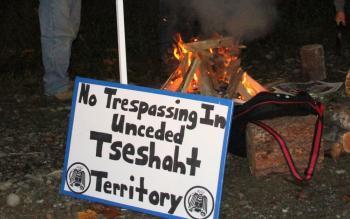
Tseshaht grassroots members who have closed the roads to industrial use at the junction of Gracie Main and Sterling Main in the Nahmint Valley (on so-called Vancouver Island) are allowing logging companies to go into the area to remove their equipment.
With the equipment off-site, it will effectively stop any more timber from being felled and returns the private property to the companies, which were caught in the middle of what Tseshahts’ describe as British Columbia Timber Sales’ “failure” to live up to expectations after a consultation meeting in September 2013. BCTS is the Crown corporation that authorizes logging companies to operate in any given cut block.
“We don’t want to hurt the families,” said Anne Robinson of the decision to allow the logging companies access. The Tseshaht grassroots members decided “around the fire” that they didn’t want to cause any hardship to the forestry companies. “The struggle isn’t with the people trying to make a living,” Robinson explained. The Tseshaht grassroots members have said from the beginning that they have no issue with logging companies, placing their concerns squarely on the doorstep of BCTS solely.
It’s a good faith move, reads a release from the group, however, “Should there be any work in the blocks, such as falling of trees, road building or attempts to remove the timber that has been cut, the road will be closed again to all industrial traffic.”
“We don’t own the equipment, but we do own the logs,” Robinson said.
BCTS met with the Tseshaht Nation at the administration building on Oct. 6.
“It went as expected,” Robinson said, without any decision-makers from BCTS in the room. She gave credit to the company’s representative Don Hudson, who Robinson said came into the meeting with sincere intentions and wanting a resolution.
“They know they fell short and didn’t meet their obligation with Tseshaht,” said Robinson of BCTS.
“We went in with the intention of trying to patch up the relationship with Tseshaht,” Hudson told Ha-Shilth-Sa. He said it felt like it was a good and respectful dialog. The intent was to get the companies back in the area and getting them back to work.
“It didn’t get that far,” he said.
Hudson and the others in the meeting, which included an observer from the Ministry of Forests, Lands and Natural Resources, didn’t have authority to deal with issues now on the table, which have gone beyond the cedar inventory and cedar management plan that the tribe had original asked for, to a discussion on aboriginal rights and title. BCTS will be approaching the minister to become involved in discussions so a resolution can be found.
But what happened? How did a consent requirement raised in consultation in September 2013 turn into direct action in 2014?
Hudson said it was a misunderstanding of [Tseshaht’s] expectation in having no further cedar logging in their territory. BCTS said they didn’t think at the time Tseshaht meant to have it apply to the sales of cut blocks that had already been made.
“It’s not in our notes,” he said of that meeting.
When asked about the blocks sold after the September 2013 meeting, Hudson said BCTS didn’t understand that it applied to those sales already contemplated, and while BCTS and Tseshaht were in discussions on the cedar inventory and cedar management plan.
When asked if BCTS had informed the companies that had purchased licenses for the cut blocks that Tseshaht had raised concerns about the cedar inventory in the area, Hudson said no, it wasn’t communicated to the companies. BCTS wasn’t aware of Tseshaht’s concern on those sales until a February 2014 letter from Tseshaht Chief Councillor Hugh Braker to the minister, Hudson said.
Hudson said BCTS didn’t know the activity in Nahmint Valley wasn’t supported by Tseshaht.
Tseshaht grassroots members have asked for a meeting of the band tomorrow evening to get everyone up to speed on what’s been happening since the road closure action began on Oct. 2. The Tseshahts will continue the road closure until a satisfactory resolution can be agreed upon, but they have agreed to allow tree planting crews into the valley for reforestation purposes.

